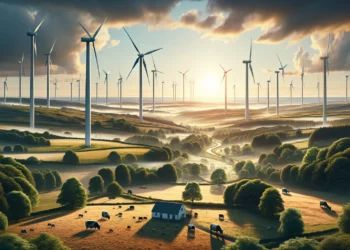
When it comes to wind turbines, size does matter. As you increase a turbine’s size, it produces increasingly cheaper energy. As a result, manufacturers have designed larger and larger turbines, culminating in the latest iteration: a 16-megawatt (MW) hybrid drive wind turbine.
The MySE 16.0-242 developed by China’s MingYang Smart Energy will feature a 242-meter diameter rotor, 118-meter long blades, and a staggering 46,000 m2 swept area equivalent to more than six soccer fields. This will make it, by quite a margin, the largest wind turbine in the world.
A single turbine, which is more than twice as tall as the Statue of Liberty, is capable of generating nearly 80 GWh of electricity every year, enough to power 20,000 households. For comparison, that’s 45% more energy than the company’s previous generation of turbines with just a 19% increase in diameter.
Besides enhancement in sheer brute force owed to the turbine’s towering size, MingYang performed a number of improvements, such as relocating all power electronics and transformers into the nacelle, as well as using lighter materials. These small tweaks add up, reducing the cost of the wind turbine — something that’s greatly needed in this industry.
Offshore wind is more expensive and therefore much less common than onshore wind. However, offshore turbines have their place in the energy mix of the future. And as manufacturers build larger and larger turbines, costs are expected to plummet.
The latest analysis, from 2020, shows the offshore wind levelized cost of energy (LCOE) fell by 28% down to 49% from 2014 to 2019. The cost of wind power, both onshore and offshore, could drop by half or more over the next 30 years, according to a study from the Lawrence Berkeley National Laboratory in the US. Offshore wind is expected to see the biggest fall in costs, with a median cost reduction of 49%, with the most optimistic scenarios putting it at 64%.
Bearing these forecasts in mind, huge turbines like MySE 16.0-242 may just be the beginning. The first full prototype rollout is scheduled for 2022 while commercial production is expected to commence in the first half of 2024.
Other manufacturers are applying the same ‘bigger is better’ strategy. Leading Danish wind turbine manufacturer Vestas announced a 15 MW offshore wind turbine for 2024. Siemens has its own 15MW model with a 222-meter rotor slated for 2024, while General Electric recently uprated the world’s current largest wind turbine in operation, the Haliade X, from 12MW to 13MW.






